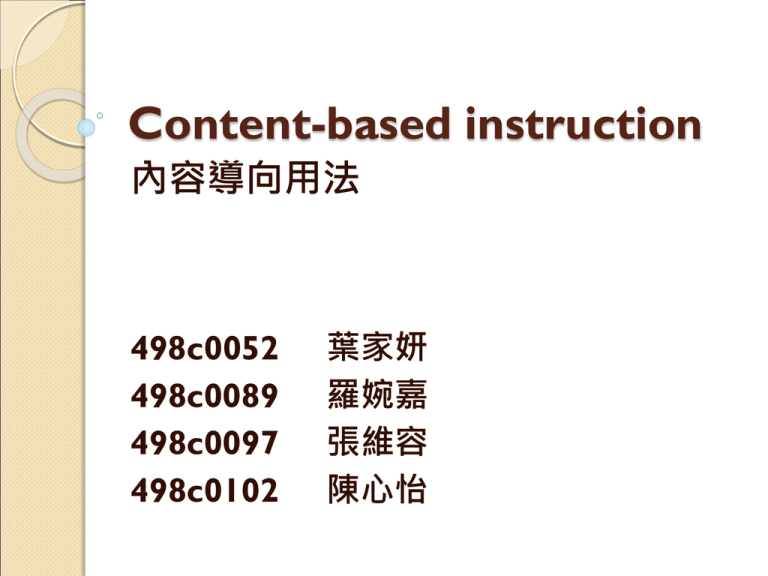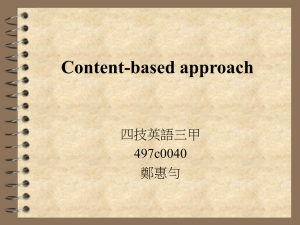Content-based instruction 內容導向用法 498c0052 葉家妍 498c0089 羅婉嘉
advertisement

Content-based instruction 內容導向用法 498c0052 498c0089 498c0097 498c0102 葉家妍 羅婉嘉 張維容 陳心怡 Introduction • • • Howatt (1984) notes that there are two versions of the Communicative Approach: a strong version and a weak version. The strong version of the Communicative Approach goes beyond giving students opportunities to practice communication. ‘using English to learn it’ The weak version could be described as ‘learning to use’ English. Rationale for Content-based instruction This is usually thought of as teaching a language for specific purposes. • In an academic setting, it might be called teaching language for academic purposes. • In competency-based instruction, adults learn language skills by studying vital ’life-coping’ or ‘survival’ skills, such as filling out job applications or using the telephone. • Such observations motivated the ‘language across the curriculum’ movement for native English speaker in England. • • • • Instructors teach academic subjects, such as history or science, while also teaching the language that is related to that content. Language thus becomes the medium for learning content. This approach can be viewed as being neither language learning, nor subject learning, but rather an amalgam of both. Teachers of CBI have to be concerned with language objectives that include vocabulary, structure, and discourse organization. Experience 1.Teacher asks the students what they know about globe. 2.Teacher distribute a hand out about “Understanding Globes.” 3.Teacher asks the students to listen as she reads the words. 4.Below the list is a modified cloze passage, students should fill in. 5.Teacher calls attention to a particular verb pattern in the cloze. 6.The students play a guessing game. 7.The teacher tells the students that they will do a dictogloss. 8.For homework, the students are given a description of Australia and a graphic organizer to help them organize and recall the new information. Experience Degree Distance Equator Globe Hemisphere Imaginary Latitude Longitude Model parallel A __________ is a threedimensional __________ of the earth. Points of interest are located on a globe by using a system of __________ lines. For instance, the equator is an imaginary line that divides the earth in half. Lines that are parallel to the equator are called lines of __________. Latitude is used to measure __________ on the earth north and south of the equator… Principles 1.The subject matter content is used for language teaching purposes 2.Teaching should build on students’ previous experience 3.When learners perceive the relevance of their language use, they are motivated to learn 4.The teacher “scaffolds” the linguistic content, i.e. helps learners say what it is they want to say by building together with the students a complete utterance 5. Language is learned most effectively when it is used as a medium to convey of interest to the students. 6.Vocabulary is easier to acquire when there are contextual clues to help convey meaning 7.Learners work with meaningful cognitively demanding language and content within the context of authentic material and tasks. 8.Communicative competence involves more than using language conversationally. It also includes the ability to read, discuss, and write about content from other fields. Techniques Q1: What are the goals of teachers who use CBI? A: Teachers want the students to master both language and content. So teachers encourage the development of both simultaneously. Q2: What is the role of the teacher? What is the role of the students? A: The teacher creates activities to teach both, scaffolding the language needed for study of the content. The students’ role is to engage actively both content and language, using each to learn the other. Q3: What are some characteristics of the teaching/learning process? A: Teachers must help learners understand authentic texts. Teachers make meaning clear through the use of visuals, realia, repeating, and by giving a lot of examples, building on students’ previous experiences. Teachers also design activities that address both language and content, and the discourse organization of the content, with specific language activities highlighting how language is used in a particular subject. Thinking skills are also taught in order to help students undertake academic tasks. Graphic organizers are one tool used to assist this process. Q4: What is the nature of student-teacher interaction? What is the nature of student-student interaction? A: The teacher guides student learning. Students often work collaboratively to understand content while actively using the language they are studying Q5: How are the feelings of the student dealt with? A: It is assumed that learning content and language together keeps students interested and motivated. Q6: How is the language viewed? How is culture viewed? A: Language is meaningful and a medium through which content is conveyed. Culture is addressed in teaching to the extent that it is present in the content area being studied. Q7: What areas of language are emphasized ? What language skills are emphasized? A: The content determines what language is worked on. The language includes not only vocabulary items and grammar structures, but also how these contributed to the discourse organization of texts. All four skills are integrated in authentic contexts. Q8: What is the role of the students’ native language? A: There is no overt role for the students’ native language Q9: How is evaluation accomplished? A: Students are evaluated on their knowledge of content and their language ability. Q10: How does the teacher respond to student errors? A: The teacher corrects student errors by giving students the correct form or allowing students to self-correct. She notes the errors, and recycles content to ensure that students are learning to use language they will need in a school context. Reviewing the Techniques Dictogloss Classroom dictation activity Students listen twice to a short talk or a reading on appropriate content. The first time, listen for the main idea. Second time, listen for details. students write down what they have remembered from the talk or reading. take notes while listening practice note-taking Construct the best version Graphic Organizers Visual displays to help students to organize and remember new information. Drawing or writing down ideas and making connections. Include diagrams, tables, columns, and webs. Help to read and complete academic texts, summarize what they have read. Key rationale in CBI: 1.facilitate recall of cognitively demanding content . 2.enabling students to process the content material at deeper level and use it for language practice. An example of a graphic organizer Language Experience Approach Student dictating own story then teacher write its down in the target language. Student practice reading story with teacher’s help. Content is significant to the students. Produce collaborative and the link between text and meaning is facilitated. Process Writing 1.brainstorm ideas about topic 2.begin writing 3.talk about the writing with teacher 4.receive feedback from teacher 5.make revisions, based on the feedback and carry on writing. Emphasis in teaching from evaluation to revision. Dialogue Journals Another way to improve literacy skills. Essentially involves students writing their journals regularly. Each class or once a week. Expressing student’s feeling about what they are learning or what they want to communicate to teacher. Teacher should be a audience for the journal. Conclusion What all CBI models have in common is learning both specific content and related language skills. In content-based language teaching, the claim in a sense is that students get “two for one”-both content knowledge and increased language proficiency. Provide an efficient manner of learning. THE END Thanks for your listening.


